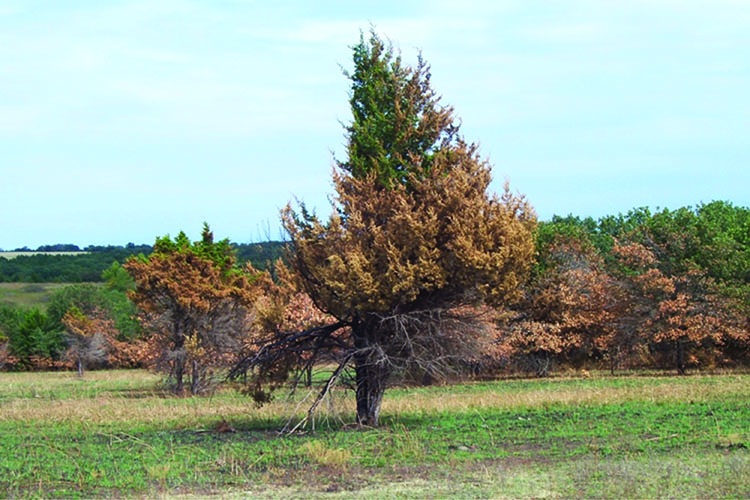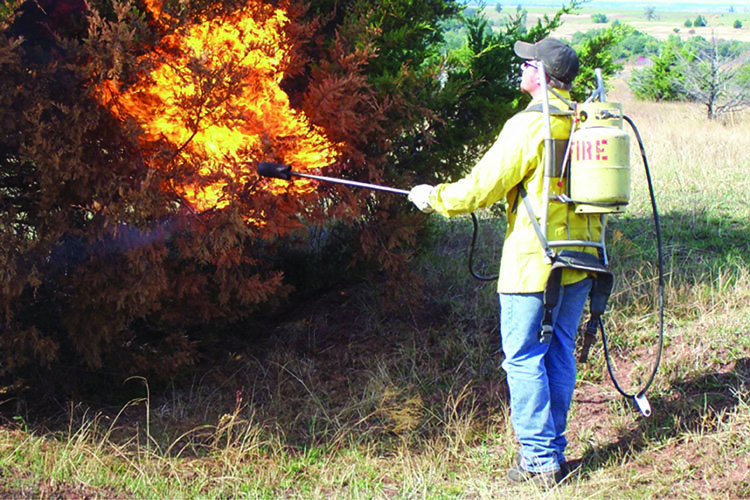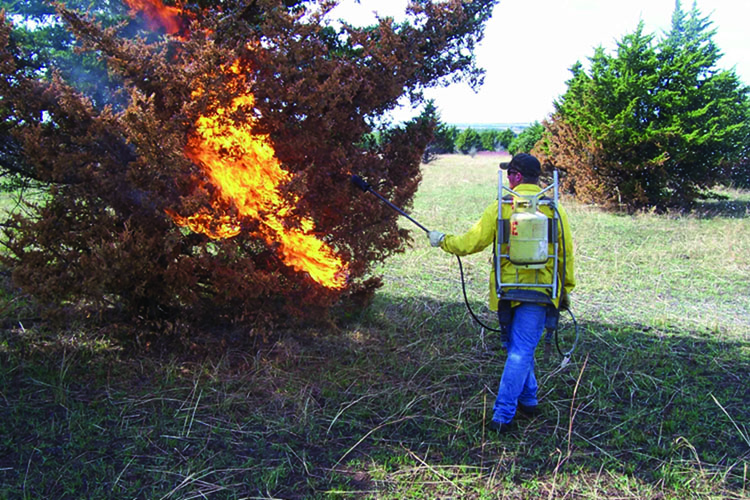Cedar Control by Individual Scorched-tree Ignition Following Fire
Prescribed burning is the most economical method to control the non-sprouting juniper species, eastern redcedar (Juniperus virginana) and ash or mountain juniper (J. asheii), in Oklahoma. Several factors influence the extent of cedar control with prescribed fire. These factors include tree height, type of fire (headfire, backfire), fuel load, fuel continuity, cedar leaf moisture and weather conditions, but tree height and fuel load are the primary factors. Cedar trees less than 1 foot tall are killed by nearly any type of fire and burning conditions. With taller trees, fuel loading becomes the most important factor. When fuel load exceeds 4,000 lbs/acre, trees from 1 foot to 5 feet tall can be consistently controlled, but tree kill declines markedly with fuel load less than 3,000 lbs/ acre. For example, if the fuel load is only 2,000 lbs/acre, about 60 percent of the cedars 5 feet tall and smaller will be killed. Cedar trees over 6 feet tall are not effectively controlled with prescribed fire with fuel loads typically found in Oklahoma. Killing trees greater than 10 feet tall require particularly heavy fine fuel loads or extreme weather conditions, which may not allow for the burn to be conducted safely. Grazed rangeland generally lack sufficient fine fuel to kill 50 percent of large cedar trees, and even without grazing, many rangelands lack the potential to produce fine fuel necessary to kill more than 50 percent of large cedar trees with a single application of prescribed fire.
All of the leaves of an eastern redcedar or Ash juniper do not have to be consumed by fire (by crowning or torching) for the tree to die. If all of the leaf material on the tree turns brown from excessive heat, the tree will die. If only the lower branches of large trees are scorched, the tree will not die. Over time, the dead needles fall and are not replaced, but the remaining green portion of the tree crown will continue to survive and grow. Fine fuel will grow under trees in which the lower part of the crown was scorched, possibly allowing subsequent fires to kill the tree. However, the use of individual tree ignition can greatly enhance and speed up this process. (Figure 1)

Figure 1. If only the lower branches of large trees are scorched, the tree will not die. Over time, the dead needles fall and are not replaced, but the remaining green portion of the tree crown will continue to survive and grow. Fine fuel will grow under trees in which the lower part of the crown was scorched, possibly allowing subsequent fires to kill the tree. However, the use of individual tree ignition can greatly enhance and speed up this process.
Individual tree ignition is a technique that can be used after a prescribed or even wildfire has burned across an area in which larger cedar trees are partly browned out (scorched) by the fire. Following these fire events, a short window of opportunity (about 2 weeks to 4 months) exists to conduct individual tree ignition. This short time span is the result of loss of dead needles that fall off due to weather and grass regrowth in the burned area that becomes dry enough to burn again. Individual ignition can begin as soon as the trees show heat damage from the fire, which is usually within one or two weeks. This technique will work on burns conducted at any time of the year, just as long as there is not enough flammable fuel remaining in the burn unit to carry another fire. We have encountered situations in which the prescribed burn was conducted on ungrazed fuels with a heavy mulch layer that was too damp to burn initially, but when individual trees were re-ignited a few weeks later, the unburned mulch layer had dried out and burned very well. Therefore, care should be exercised when dry fuel is present in the burn unit.
A propane cylinder fitted with a weed burner torch, a drip torch, or a disposable hand-held propane or MAP gas torch can be used to ignite trees. A 3 gallon (10 lb) cylinder and weed burner works the best and is easy to handle, especially if attached to backpack frame. The 5 gallon (20 lb) propane cylinder with a weed burner works well if mounted securely to an ATV and travel is restricted to areas that can be safely accessed by the vehicle. The person(s) igniting the trees should wear leather gloves, a helmet or cap to keep falling embers from burning their hair, along with long pants and a long sleeve shirt made of all cotton or fire-retardant material.
When re-lighting trees, the heat and flames should go nearly straight up to consume or heat damage the remaining live portion of the tree. The best conditions for igniting trees is when the leaves are dried to equilibrium with atmospheric moisture, which is usually in late afternoon, when wind is less than 5 mph and air temperature is greater than 75F. When wind speed is more than 10 mph, it greatly reduces the effectiveness of this technique by tilting the heat and flame away from the upper portion of the tree and only burning the lower browned portion.
With proper conditions, ignite a single point on small trees or several points on larger trees along the browned lower branches on the windward side. It is also best to work into the wind; this allows the person igniting to stay out from under the falling embers while lighting other trees. Some trees ignite better than others due to leaf density and branch structure. In a research study, the time to ignite trees averaged about 19 seconds per tree, so numerous trees can be treated within a short period of time depending upon tree density and topography. (Figure 2)

Figure 2. With proper conditions ignite a single point on small trees or several points on larger trees along the browned lower branches on the windward side. It is also best to work into the wind; this allows the person igniting to stay out from under the falling embers while lighting other trees.
When igniting scorched cedar trees, the proper authorities, such as local fire department, county sheriff and division of forestry representative in forest protection areas should be notified prior to burning, along with adjoining landowners. You should also have some type of fire suppression equipment available, and if possible, another person to function as a spotter, especially if burning near adjacent unburned areas. Firebrands can ignite spot fires more than 300 feet away when air temperatures are above 80F, and the probability of spot fires is greater when relative humidity is below 40 percent. (Figure 3)

Figure 3. When igniting scorched cedar trees, the proper authorities, such as local fire department, county sheriff and division of forestry representative in forest protection areas should be notified prior to burning, along with adjoining landowners. You should also have some type of fire suppression equipment available and if possible another person to function as a spotter, especially if burning near adjacent unburned areas.
Igniting scorched cedar trees, using current labor and propane costs and 10 percent annual depreciation on equipment costs about $10.17/acre or $0.04/tree to treat an 80 acre area with 230 cedar trees/acre. This cost will vary with number of trees, size of trees, and terrain. But compared to mechanical and chemical control this cost is considerably less.
John R Weir
Research Associate, Natural Resource Ecology and Management
David M Engle
Regents Professor and Director, Water Research and Extension Center
